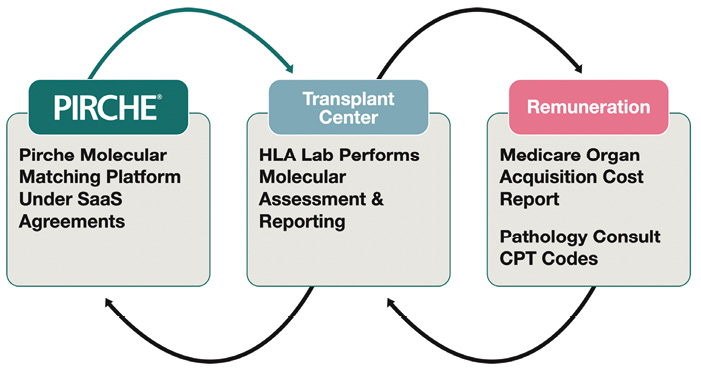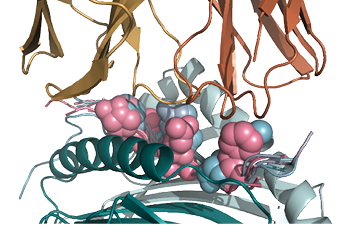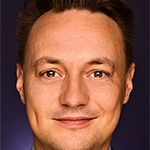Bildnachweis: Who is Danny – stock.adobe.com, Source: PIRCHE AG, © PIRCHE AG, PIRCHE AG.
PIRCHE‘s IT platform combines genetic typing with AI-assisted real-time simulations of protein-protein interactions. Tailored for immunologists, nephrologists, oncologists, and leukemia specialists, the platform serves as a precision tool for personalised decision-making in transplantation medicine and immunotherapy.
In the landscape of organ transplants, where a significant percentage of transplanted organs cease functioning within 5 to 10 years, PIRCHE addresses a critical need. For instance, kidney transplant patients, faced with the grim prospect of dialysis three to four times a week, confront not only the absence of a cure but also substantial side effects from dialysis treatments, ultimately compromising their quality of life.
Challenges of HLA genotypes in organ transplants
The challenge lies in the rejection of transplanted organs due to insufficient compatibility. Traditional compatibility testing, based on limited data and criteria, often falls short. Factors considered – in addition to the recipient’s waiting time for a donor – include donor and recipient gender, blood groups, and Human Leukocyte Antigens (HLAs) which play a central role in the immunological recognition of “self“ and “other”. Each person has dozens of these „genetic sites“, each of which may have one out of thousands of possible characteristics that determine the individual make up of each person’s immune system. Prior to an organ transplant, it must be checked whether or not a subset of these genes are the same in the donor and recipient. However, given the combinatorial complexity brought about by these variations, an identically configured immune system is the exception.

Innovative technology for exact compatibility checks
There are currently 34,000 known alleles (genetic variations) that play a role in the question of whether a donor organ is a good match for a patient. At the same time, a classic comparison of these alleles ignores key immunobiological differences. Enter PIRCHE AG, offering a solution that seamlessly integrates genetic typing with AI-driven predictions of protein-protein interactions. By matching virtual genotypes and aggregating them based on population frequencies, the platform establishes „epitope compatibility“ (the matching of surface molecules, especially HLA antigens), simplifying the setting of individual thresholds for patients. The name „PIRCHE“ is itself an acronym for this matching and prediction technology, standing for „Predicted Indirectly ReCognisable HLA Epitopes.“
Data representation and analysis
This fully digital technology is based on the results of routine clinical laboratory tests which are already a standard of care. Connected via APIs to the IT systems of leading laboratory service providers, the platform is accessible on standard media devices. It calculates PIRCHE totals, offering quick insights into the match accuracy of a donor organ with a recipient through a visually intuitive „heat map.“ Users can delve into matching details, predicting the location of peptides from certain mismatches, providing valuable context to the results. In addition, a presentation table lists all the information generated during the calculation. The result details can also be transferred to the user‘s own statistics using a CSV file and analysed individually.

PIRCHE’s dissemination and growth strategy
Supported by over 70 peer-reviewed publications and validated through 200,000 patient cases, PIRCHE‘s technology promises better outcomes, fewer complications, and an improved quality of life. Backed by 25 issued patents globally and exclusive commercial rights for „Linked Recognition,“ the sequential interaction of B-cell and T-cell epitope matching, PIRCHE has garnered more than 850 leading clinics worldwide as registered users. The company‘s strategic growth model, seamlessly integrating its web platform via license agreements with global laboratory service providers, positions PIRCHE for robust expansion, particularly in the USA.

Expansion to new application areas
While primarily active in transplant medicine, with a keen focus on kidney transplantation, PIRCHE is actively diversifying into autoimmune diseases and oncology for cell therapeutics. Beyond transplantation, PIRCHE‘s platform empowers doctors and specialists to make informed decisions about treatment plans for cancer patients, grounded in their genetic predisposition. The technology also predicts and quantifies long-term immune risk and responses to xenografts, serving as a data-driven decision support tool for achieving graft survival rates of 20 years or more. PIRCHE’s technology is also used for stem cell transplants in haematological applications.
SHORT PROFILE OF PIRCHE AG
Foundation: 7 September 2015
Sector: Transplant medicine/Healthcare
Location(s): Medfield (Massachusetts, USA), Grünwald (Germany)
Employees: 14
Internet: https://pirche.com
This article was published in the current Plattform Life Sciences issue „Circular Bioeconomy 4_23“, which you can view as an e-magazine via the following link:
https://www.goingpublic.de/wp-content/uploads/epaper/epaper-Life-Sciences-4-2023/#52
Autor/Autorin

Urs Moesenfechtel
Urs Moesenfechtel, M.A., ist seit 2021 Redaktionsleiter der GoingPublic Media AG - Plattform Life Sciences und für die Themenfelder Biotechnologie und Bioökonomie zuständig. Zuvor war er u.a. Wissenschaftsredakteur für mehrere Forschungseinrichtungen tätig.



